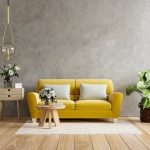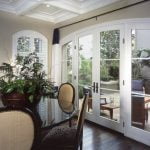Pinterest has become a treasure trove of home decor inspiration for individuals looking to beautify their living spaces. However, as the platform’s popularity continues to soar, a question arises: do Pinterest home decor start to look the same? With millions of users worldwide turning to Pinterest for design ideas and DIY projects, there is a growing concern that the once diverse and innovative world of home decor on the platform may be becoming homogenized.
The appeal of Pinterest lies in its ability to curate visually appealing images and ideas, making it a go-to source for those seeking creative inspiration for their homes. From minimalist Scandinavian interiors to bohemian chic designs, Pinterest offers a vast array of styles and trends to suit every taste. However, with the rise of certain trends dominating the platform, there is a noticeable shift towards a more uniform aesthetic in Pinterest home decor.
Trends play a significant role in shaping the look of Pinterest boards, with popular design movements such as farmhouse style or mid-century modern influencing the choices made by users when pinning home decor ideas. Additionally, influential designers and lifestyle bloggers contribute to this phenomenon by showcasing their own curated looks, which in turn impact what users see and save on their own boards.
As a result, Pinterest home decor can start to feel repetitive and familiar, giving rise to the question of originality in an increasingly saturated space.
The Influence of Trends
Pinterest has become a go-to platform for home decor inspiration, with millions of users turning to the site to gather ideas and design tips for their living spaces. However, as the platform continues to grow in popularity, a common observation is that many Pinterest home decor ideas start to look the same. This phenomenon can be attributed to various factors, one of which is the influence of trends on the visual aesthetic of Pinterest boards.
Trends play a significant role in shaping the look and feel of home decor on Pinterest. Whether it’s a particular color palette, a specific design style, or certain decorating accessories, trends tend to dominate the platform and influence what users pin to their boards. As certain trends gain traction within the world of interior design, they inevitably find their way onto Pinterest boards, creating a sense of homogeneity in terms of home decor inspiration.
Moreover, influential designers and bloggers within the home decor industry also contribute to the uniformity of Pinterest home decor ideas. These tastemakers often set the tone for what is considered stylish and chic in interior design, leading followers on Pinterest to emulate their curated looks. As a result, many users may find themselves replicating similar design elements and aesthetics seen on popular influencers’ boards, further perpetuating the cycle of sameness in Pinterest home decor.
Impact of Influencers
In the realm of Pinterest home decor, there is an undeniable influence wielded by designers and bloggers who have amassed a significant following. These influencers have the power to shape trends and dictate what is considered aesthetically pleasing in the world of interior design.
As a result, many Pinterest boards filled with home decor ideas tend to mirror the style preferences advocated by these influential figures. From minimalist Scandinavian designs to bohemian chic styles, the plethora of options available on Pinterest often seem to converge towards a few popular aesthetics.
One way in which influential designers and bloggers leave their mark on Pinterest home decor is through collaborations with brands. By showcasing sponsored products and incorporating them into their designs, these influencers inadvertently promote certain trends and styles that may become pervasive across the platform. Additionally, their curated boards and carefully crafted images serve as inspiration for countless users who seek to emulate their impeccable taste in home decor.
- Collaborations with brands help promote specific trends
- Influencers create curated boards that inspire users
The rise of social media has enabled designers and bloggers to reach a wider audience than ever before, further solidifying their impact on the aesthetic choices seen on Pinterest. While this can result in a homogenization of home decor ideas on the platform, it also provides an opportunity for users to discover new styles and techniques that they may not have otherwise encountered.
By following a diverse range of influencers and exploring unconventional sources of inspiration, Pinterest users can break free from the cycle of repetitive decor trends and create spaces that truly reflect their unique personalities.
- Social media amplifies influencer impact on Pinterest home decor
- Diverse sources of inspiration can help break away from common trends
DIY Culture
DIY projects have become a staple in the world of home decor, offering individuals the opportunity to personalize their living spaces and unleash their creativity. However, as Pinterest has skyrocketed in popularity as a platform for home decor inspiration, a common concern arises – do Pinterest home decor start to look the same? The answer lies in the prevalence of DIY culture and its influence on the homogeneity of design aesthetics found on the platform.
One of the primary reasons why Pinterest home decor tends to have a uniform appearance is due to the widespread availability of DIY tutorials and projects online. While these resources can be incredibly useful for individuals looking to revamp their homes on a budget, they also contribute to a sense of sameness in design choices.
From painted mason jars to geometric wall art, certain DIY trends become so popular that they saturate Pinterest boards, leading to a replication of similar styles across different users’ profiles.
Moreover, the allure of DIY projects lies in their accessibility and ease of execution, making it tempting for individuals to follow tried-and-tested methods rather than venture into uncharted territory. As a result, many Pinterest users may find themselves replicating popular DIY trends without adding their own twist or personal touch. This phenomenon further exacerbates the perception that Pinterest home decor starts to look alike, as originality takes a backseat to conformity in pursuit of achieving picture-perfect interiors.
| Key Point | Explanation |
|---|---|
| Role of DIY Tutorials | DIY tutorials contribute to a sense of similarity in Pinterest home decor by popularizing specific projects. |
| Accessibility of DIY Projects | The accessibility and simplicity of DIY projects make it easier for individuals to replicate existing trends instead of innovating. |
| Lack of Personalization | Many users may forego adding personal touches when following popular DIY trends, leading to a cohesive yet somewhat generic look across Pinterest boards. |
The Role of Algorithms
Pinterest’s algorithms play a significant role in shaping the similarity seen in home decor ideas on the platform. These algorithms are designed to curate content based on users’ interests, preferences, and behaviors.
As users engage with certain types of home decor posts, Pinterest’s algorithm identifies patterns and begins to prioritize similar content in their feeds. This creates a cycle where users are exposed to a narrow range of styles and trends, ultimately leading to a homogenized look across many Pinterest boards.
Personalization or Paralysis
While the goal of algorithms is to provide users with personalized content that aligns with their tastes, it can sometimes lead to a phenomenon known as “personalization paralysis.” This occurs when users are repeatedly shown similar content, limiting their exposure to new and diverse ideas. As a result, Pinterest home decor boards may start to echo each other, lacking individuality and creativity.
The Echo Chamber Effect
The algorithms on Pinterest can also contribute to what is known as the “echo chamber effect,” where users are constantly presented with content that reinforces their existing beliefs or tastes. In terms of home decor, this means that if a user engages with a specific style or trend, they are likely to see more of the same, further narrowing their perspective.
This can perpetuate the cycle of similarity in Pinterest home decor and make it challenging for users to discover unique ideas outside of their established preferences.
In order to combat the homogenization of Pinterest home decor, it is essential for users to actively seek out new sources of inspiration and consciously diversify their feed by engaging with different styles and aesthetics. By intentionally exploring beyond their comfort zone and experimenting with various DIY projects, materials, colors, and layouts, individuals can break free from the algorithmic constraints and infuse their personal touch into their home decor boards on Pinterest.
Pinterest vs Reality
Pinterest home decor boards are filled with picture-perfect images of impeccably styled rooms, curated to perfection. From pristine white kitchens to cozy living rooms with perfectly placed throw pillows, the aesthetic appeal of these images is undeniable. However, when it comes to translating these ideas into reality, many DIY enthusiasts and decorators may find themselves facing challenges and discrepancies between their Pinterest boards and their actual living spaces.
Expectations vs Reality
One of the main reasons why Pinterest home decor ideas may not always translate seamlessly into real-life spaces is the unrealistic expectations set by these perfectly curated images. The lighting, angles, and styling in Pinterest photos are often carefully orchestrated to create a flawless look that may not be achievable in everyday living.
In reality, homes are lived-in spaces that are subject to wear and tear, natural light fluctuations, and personal touches that may not align with the pristine images found on Pinterest.
Budget Constraints
Another factor that can contribute to the disparity between Pinterest inspiration and real-life home decor is budget constraints. Many Pinterest boards feature high-end designer furniture, custom finishes, and luxury decor items that may not be feasible for everyone’s budget.
When trying to recreate these looks on a limited budget, DIYers may have to compromise on certain elements or find creative alternatives to achieve a similar aesthetic. This can lead to a deviation from the original Pinterest inspiration but can also result in a uniquely personalized space that reflects individual style and creativity.
Breaking the Mold
Pinterest has undoubtedly become a go-to destination for home decor inspiration, with millions of users pinning and sharing ideas to create their dream spaces. However, as the platform’s popularity continues to soar, many have started questioning: do Pinterest home decor start to look the same? The answer can often lean towards yes, as trends, influencers, DIY culture, and algorithms all play a role in shaping the aesthetic of Pinterest boards.
To break away from the cookie-cutter look that can sometimes dominate Pinterest home decor feeds, here are some tips and ideas for creating unique and personalized spaces:
1. Personalize with Meaningful Decor: Instead of simply following the latest trends or replicating popular pins, consider incorporating pieces that hold sentimental value or reflect your personal interests. Whether it’s family heirlooms, travel souvenirs, or handmade crafts, adding these touches can make your space feel truly unique.
2. Mix Styles and Eras: Don’t feel confined to a single design style – mix and match different aesthetics to create a space that is eclectic and reflective of your personality. Combining modern furniture with vintage finds or introducing elements from various design eras can add depth and character to your home decor.
3. DIY Projects with a Twist: While DIY projects are prevalent on Pinterest, put your spin on them by adding unexpected details or personal touches. Think outside the box when it comes to materials, colors, or purposes for your DIY creations to ensure they stand out from the crowd.
By challenging the norm and infusing your personal style into your Pinterest home decor boards, you can create spaces that are not only visually appealing but also uniquely yours. Embrace creativity and individuality in your design choices to break away from the homogenous look that can sometimes plague Pinterest-inspired spaces.
Conclusion
As we have explored the world of Pinterest home decor, it becomes evident that the platform has indeed become a hub for inspiration but has also inadvertently led to a homogenized look in many boards. The influence of trends, influencers, DIY culture, and algorithms all play a role in shaping the aesthetic of Pinterest home decor, often making them start to look the same.
While this can be disheartening for those looking to create personalized spaces, there are ways to break the mold and inject uniqueness into your home decor.
Looking ahead, it is essential for Pinterest users to be mindful of creating spaces that truly reflect their individuality and style rather than replicating what they see on their feeds. By consciously choosing pieces that resonate with them personally and incorporating DIY projects with a personal touch, individuals can create homes that stand out from the crowd. Additionally, seeking inspiration beyond Pinterest and exploring different design styles can also help in cultivating a more unique home decor aesthetic.
In conclusion, while Pinterest may sometimes lead to a uniform look in home decor ideas, it ultimately comes down to the user’s creativity and willingness to think outside the box. By taking cues from trends but infusing their personality into their spaces, individuals can ensure that their homes reflect who they are rather than conforming to a generic standard.
In the end, Pinterest should serve as a tool for inspiration rather than dictating how one’s home should look, allowing for diverse and individualized expressions of style within the realm of home decor.
Frequently Asked Questions
What Home Decor Style Is Trending Right Now?
The home decor style that is currently trending right now is modern farmhouse. This style combines the sleekness of modern design with the warmth and charm of rustic farmhouse elements, creating a cozy yet stylish look for homes.
Do Interior Designers Use Pinterest?
Yes, interior designers do use Pinterest extensively for inspiration and ideas. It serves as a valuable tool for them to gather images, color schemes, furniture styles, and decor trends to create mood boards and presentations for their clients.
Does Home Decor Have to Match?
Home decor doesn’t necessarily have to match perfectly. Mixing different styles, textures, and colors can actually create a more interesting and personalized look in your home. The key is finding a cohesive element that ties everything together, such as a common color scheme or theme.

I’m thrilled to be your companion on this exciting journey through the world of home decor and design. With a passion for turning houses into homes and a keen eye for the finer details, I’m here to help you transform your living spaces into beautiful, functional, and meaningful havens.





